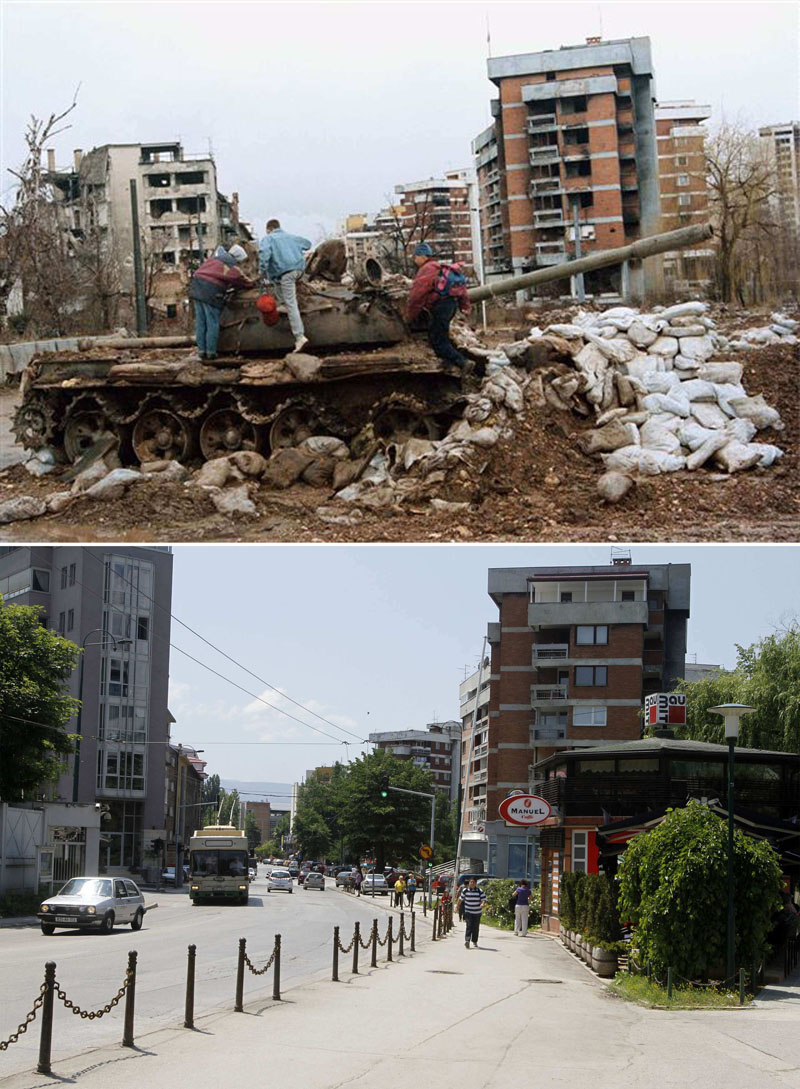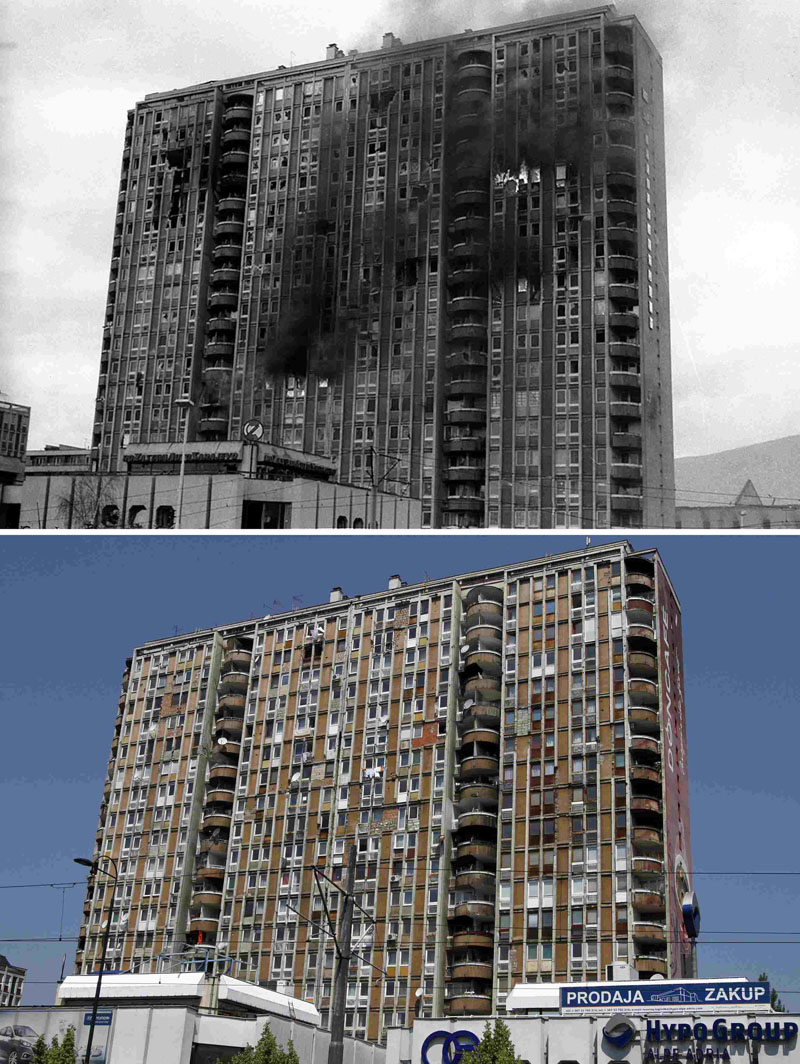RESTRICTED TO EDITORIAL USE - MANDATORY CREDIT POLITIKA NEWSPAPER - NO MARKETING NO ADVERTISING CAMPAIGNS - DISTRIBUTED AS A SERVICE TO CLIENTS Combo picture shows on left Bosnian Serb former army chief Ratko Mladic (L) on February 15, 1994 and on right a picture of Mladic provided on May 27, 2011 by the Serbian daily newspaper "Politika." Former military chief Ratko Mladic appeared in court on May 27, 2011, hours after his arrest in Serbia ended a 16-year manhunt for the general accused of masterminding the 1995 Srebrenica massacre. Europe's most-wanted man was arrested in the early hours of May 27 in a village in northern Serbia, but there were immediately questions over whether the 69-year-old Bosnian Serb was fit to stand trial after he claimed to be ill. AFP PHOTO
Hace ya más de 19 años que Mladic comandó un brutal asedio a la ciudad de Sarajevo en la que fue la guerra de Bosnia. Es el mismo tiempo que ha tardado la justicia internacional en presentar cargos, encontrarle, detenerle y ponerle a disposición del Tribunal Penal Internacional acusado por multiples crímenes.
La agencía Reuters ha pasado unos combos de imágenes que nos llevan desde las calles de la actual Sarajevo a la ciudad que Mladic creó a base de bombas y muerte. Un viaje que nos recuerda lo delgada que es la línea entre la paz y la guerra, entre la cordura y la locura.
A combination photo shows (upper) a disused tank standing at a crossroad in front of a ruined building in the Kovacici district in Sarajevo February 1996 and (lower) people walking along the same road in the Kovacici district in Sarajevo May 30, 2011. Sarajevo announced plans on Monday to open a museum of its brutal siege by Bosnian Serb forces, saying the approaching trial of their commander Ratko Mladic made it all the more important to display the evidence. The museum will open on the siege's 20th anniversary next year and organisers said the timing of the announcement, four days after Mladic's capture in Serbia after nearly 16 years evading war crimes charges, was coincidental but fortuitous. In the early 1990s, the Bosnian capital became a symbol of suffering of its citizens, who remained stuck in the city for 3-1/2-years under daily shelling by heavy artillery and snipers from nearby hills, without water, power and food. REUTERS/Staff (BOSNIA AND HERZEGOVINA - Tags: CONFLICT POLITICS CITYSCAPE CRIME LAW)

A combination photo shows (upper) the wreckage of a tram in a street following shelling in the Skenderija district in Sarajevo March 1992 and (lower) a tram travelling along the same street in the Skenderija district in Sarajevo May 30, 2011. Sarajevo announced plans on Monday to open a museum of its brutal siege by Bosnian Serb forces, saying the approaching trial of their commander Ratko Mladic made it all the more important to display the evidence. The museum will open on the siege's 20th anniversary next year and organisers said the timing of the announcement, four days after Mladic's capture in Serbia after nearly 16 years evading war crimes charges, was coincidental but fortuitous. In the early 1990s, the Bosnian capital became a symbol of suffering of its citizens, who remained stuck in the city for 3-1/2-years under daily shelling by heavy artillery and snipers from nearby hills, without water, power and food. REUTERS/Staff (BOSNIA AND HERZEGOVINA - Tags: CONFLICT POLITICS CITYSCAPE CRIME LAW)
A combination photo shows (upper) a building burning after being shelled in the Pofalici district in Sarajevo April 1992, and (lower) the same building pictured May 30, 2011. Sarajevo announced plans on Monday to open a museum of its brutal siege by Bosnian Serb forces, saying the approaching trial of their commander Ratko Mladic made it all the more important to display the evidence. The museum will open on the siege's 20th anniversary next year and organisers said the timing of the announcement, four days after Mladic's capture in Serbia after nearly 16 years evading war crimes charges, was coincidental but fortuitous. In the early 1990s, the Bosnian capital became a symbol of suffering of its citizens, who remained stuck in the city for 3-1/2-years under daily shelling by heavy artillery and snipers from nearby hills, without water, power and food. REUTERS/Staff (BOSNIA AND HERZEGOVINA - Tags: CONFLICT POLITICS CITYSCAPE CRIME LAW)



Comentarios
<% if(canWriteComments) { %> <% } %>Comentarios:
<% if(_.allKeys(comments).length > 0) { %> <% _.each(comments, function(comment) { %>-
<% if(comment.user.image) { %>
![<%= comment.user.username %>]() <% } else { %>
<%= comment.user.firstLetter %>
<% } %>
<% } else { %>
<%= comment.user.firstLetter %>
<% } %>
<%= comment.user.username %>
<%= comment.published %>
<%= comment.dateTime %>
<%= comment.text %>
Responder
<% if(_.allKeys(comment.children.models).length > 0) { %>
<% }); %>
<% } else { %>
- No hay comentarios para esta noticia.
<% } %>
Mostrar más comentarios<% _.each(comment.children.models, function(children) { %> <% children = children.toJSON() %>-
<% if(children.user.image) { %>
![<%= children.user.username %>]() <% } else { %>
<%= children.user.firstLetter %>
<% } %>
<% } else { %>
<%= children.user.firstLetter %>
<% } %>
<% if(children.parent.id != comment.id) { %>
en respuesta a <%= children.parent.username %>
<% } %>
<%= children.user.username %>
<%= children.published %>
<%= children.dateTime %>
<%= children.text %>
Responder
<% }); %>
<% } %> <% if(canWriteComments) { %> <% } %>